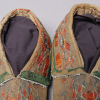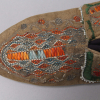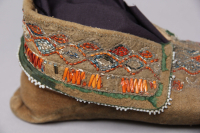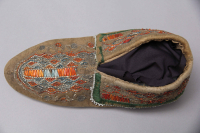moccasins
moccasins
moccasins















A pair of Hodenosaunee moccasins from about 1830, attributed to the Seneca. Made of hide sewn with central seam and folded cuffs. Ornamented with quillwork in zig-zag band and single line stitch. Transferred to Museum Volkenkunde from the Koninklijk Kabinet van Zeldzaamheden (The Royal Cabinet of Curiosities) in The Hague when it closed in 1883.
Museum documentation
GRASAC generated
Read More About This Relative
hide; porcupine quills; possibly natural cotton(?); silk ribbon; glass beads
The moccasins appear to have a single piece construction with seams up the centre of the vamp and heel. A single row of zigzag band quillwork covers the central seam with porcupine quills applied in simple line decorated on either side in zigzags, diamonds, triangles, wavy lines, circles and 'V' shapes. The folded cuffs are ornamented with porcupine quills in zigzag band and simple line, and edged with green silk ribbon and white glass beads. Moccasins appear to be lined with natural cotton fabric.
Zigzag and wavy lines, diamonds, triangles, wavy line with alternating circles and 'V' shapes along the outer sides of the vamp. On the cuffs, zigzag and wavy lines, diamonds.
Museum documentation
Provenance
Koninklijk Kabinet van Zeldzaamheden (The Royal Cabinet of Curiosities) in The Hague was established by King Willem I in 1816. When it was dissolved in 1883, the ethnographic collections were transferred to Museum Volkenkunde (The National Museum of Ethnology) in Leiden.
About This GRASAC Record













 Knowledge Sharing Platform
Knowledge Sharing Platform














